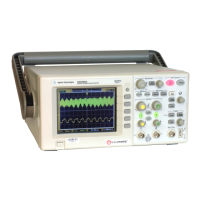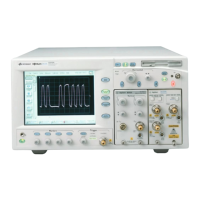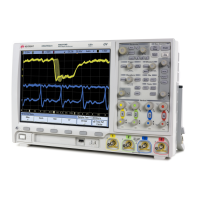1074 Agilent InfiniiVision 3000 X-Series Oscilloscopes Programmer's Guide
35 Obsolete and Discontinued Commands
:MEASure:TVOLt
(see page 1138)
Query Syntax
:MEASure:TVOLt? <value>, [<slope>]<occurrence>[,<source>]
<value> ::= the voltage level that the waveform must cross.
<slope> ::= direction of the waveform. A rising slope is indicated by
a plus sign (+). A falling edge is indicated by a minus
sign (-).
<occurrence> ::= the transition to be reported. If the occurrence
number is one, the first crossing is reported. If
the number is two, the second crossing is reported,
etc.
<source> ::= {<digital channels> | CHANnel<n> | FUNCtion | MATH}
<digital channels> ::= {DIGital<d>} for the MSO models
<n> ::= 1 to (# analog channels) in NR1 format
<d> ::= 0 to (# digital channels - 1) in NR1 format
When the :MEASure:TVOLt? query is sent, the displayed signal is searched
for the specified voltage level and transition. The time interval between the
trigger event and this defined occurrence is returned as the response to
the query.
The specified voltage can be negative or positive. To specify a negative
voltage, use a minus sign (- ). The sign of the slope selects a rising (+) or
falling (- ) edge. If no sign is specified for the slope, it is assumed to be
the rising edge.
The magnitude of the occurrence defines the occurrence to be reported.
For example, +3 returns the time for the third time the waveform crosses
the specified voltage level in the positive direction. Once this voltage
crossing is found, the oscilloscope reports the time at that crossing in
seconds, with the trigger point (time zero) as the reference.
If the specified crossing cannot be found, the oscilloscope reports
+9.9E+37. This value is returned if the waveform does not cross the
specified voltage, or if the waveform does not cross the specified voltage
for the specified number of times in the direction specified.
If the optional source parameter is specified, the current source is
modified.
Return Format
<value><NL>
The :MEASure:TVOLt command is obsolete and is provided for backward compatibility to
previous oscilloscopes. Use the :MEASure:TVALue command (see page 454).

